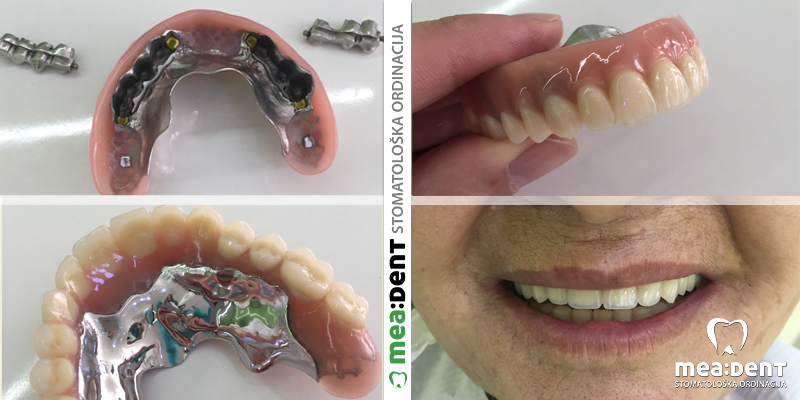O.Č. born in 1946
Visil denture on dental implants
Patient O.C., born in 1946, has contacted us because for several years she has had an issue with the two dentures she had made. Flippancy and hastiness after an advice given by a dentist whom she contacted five years ago, resulted in extraction of all her teeth and implantation of even 10 dental implants in her upper jaw and 7 implants in her lower jaw. An inadequate treatment by a dentist and the patient who was not a good candidate for implants resulted in loss of 4 implants in the lower jaw and 3 implants in the upper jaw.
We made an orthopan panoramic radiograph of all dental implants and saw that implants remaining in the bone were in a good condition, and that dentures the patient wore were not stabile due to unsuitable design, so that in occlusion she used to knock over the right side of the denture. Even after numerous attempts to make denture stable, we could not achieve stability by any means.
The basic issue was in the dedicated crowns design and denture bed for that same crowns. In order to be stable in the mouth, a denture made of metal must very precisely fit dedicated crowns and lock with them. That is why a special care must be taken during designing in the laboratory. Rubber bands that are inside the denture, so-called attachment system (fasteners), serve for denture retention (so that denture would not detach and be lifted).
Such combined work is very difficult to make, since even the slightest mistake in making, and specially during permanent cementing could disturb everything. To make it clear, regular dentures have 4 elements that hold denture, 2 milled crowns and 1 pair of attachments. This work on implants had 7 milled dedicated crowns and 2 pairs of attachments, which represents total of 11 elements for denture holding. It would be enough that only 1 element was incorrectly placed and the denture would be falling off.
After two hours of preparation, we have cemented all crowns, carefully adjusted the denture and checked the occlusion (contact of the upper and lower teeth). Also, a balanced bilateral occlusion is important here (a patient should have bilaterally balanced contacts on all teeth).
At the first follow-up we have finally achieved that the denture was not falling off in occlusion, and the patient was very surprised because she had thought that she “could not be helped”.






